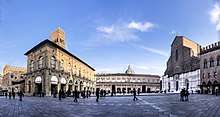Bologna
| Bologna | |||
|---|---|---|---|
| Comune | |||
| Comune di Bologna | |||
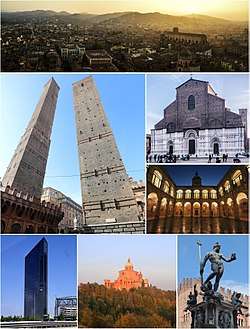 Clockwise from top: panorama of Bologna and the surrounding hills, San Petronio Basilica, University of Bologna, Fountain of Neptune, Sanctuary of the Madonna di San Luca, Unipol Tower and the Two Towers | |||
| |||
| Nickname(s): The Learned One, the Fat One, the Red One | |||
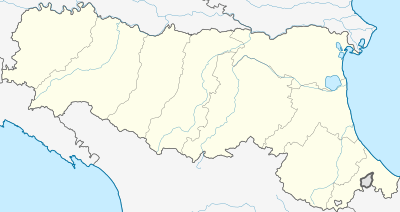 Bologna Location of Bologna in Emilia-Romagna  Bologna Bologna (Italy)  Bologna Bologna (Europe) | |||
| Coordinates: 44°30′27″N 11°21′5″E / 44.50750°N 11.35139°ECoordinates: 44°30′27″N 11°21′5″E / 44.50750°N 11.35139°E | |||
| Country | Italy | ||
| Region | Emilia-Romagna | ||
| Metropolitan city | Bologna (BO) | ||
| Government | |||
| • Mayor | Virginio Merola (PD) | ||
| Area[1] | |||
| • Total | 140.86 km2 (54.39 sq mi) | ||
| Elevation | 54 m (177 ft) | ||
| Population (27 July 2018)[2] | |||
| • Total |
390,198 (urban) 1,010,389 (metro) | ||
| Demonym(s) | Bolognesi | ||
| Time zone | UTC+1 (CET) | ||
| • Summer (DST) | UTC+2 (CEST) | ||
| Postal code | 40100 | ||
| Dialing code | 051 | ||
| ISTAT code | 037006 | ||
| Patron saint | St. Petronius | ||
| Saint day | 4 October | ||
| Website | Official website | ||
Bologna (/bəˈloʊnjə/, also UK: /bəˈlɒnjə/; Italian: [boˈloɲːa] (![]()
Of Etruscan origin, the city has been a major urban centre for centuries, first under the Etruscans, then under the Romans (Bononia), then again in the Middle Ages, as a free municipality and signoria, when it was among the largest European cities by population. Famous for its towers, churches and lengthy porticoes, Bologna has a well-preserved historical centre, thanks to a careful restoration and conservation policy which began at the end of the 1970s.[3] Home to the oldest university in the world,[4][5][6][7][8] the University of Bologna, established in AD 1088, the city has a large student population that gives it a cosmopolitan character. In 2000 it was declared European capital of culture[9] and in 2006, a UNESCO "City of Music" and became part of the Creative Cities Network.[10]
Bologna is an important agricultural, industrial, financial and transport hub, where many large mechanical, electronic and food companies have their headquarters as well as one of the largest permanent trade fairs in Europe. According to the most recent data gathered by the European Regional Economic Growth Index (E-REGI) of 2009, Bologna is the first Italian city and the 47th European city in terms of its economic growth rate.[11] As a consequence, Bologna is also one of the wealthiest cities in Italy, often ranking as one of the top cities in terms of quality of life in the country: in 2011 it ranked 1st out of 107 Italian cities.[12]
History
Antiquity and Middle Ages
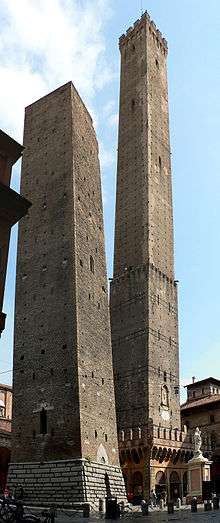
.jpg)
First settled around 1000 BCE and then founded as the Etruscan Felsina about 500 BCE, it was occupied by the Boii in the 4th century BCE and became a Roman colony and municipium with the name of Bononia in 196 BCE.[13] After the fall of the Roman Empire, Bologna, then a frontier outpost of the Byzantine Exarchate of Ravenna was repeatedly sacked by the Goths; it is in this period that legendary Bishop Petronius, according to ancient chronicles, rebuilt the ruined town and founded the basilica of Saint Stephen.[14] Petronius is still revered as patron saint of Bologna.
In 727-28, the city was sacked and captured by the Lombard under King Liutprand, becoming part of that kingdom. These Germanic conquerors built an important new quarter, called "addizione longobarda" (Italian for "Longobard addition") near the complex of St. Stephen.[15] In the last quarter of the 8th century, Charlemagne, at the request of Pope Adrian I, invaded the Lombard Kingdom, causing its eventual demise. However Bologna, occupied by Frankish troops in 774 on behalf of the papacy, remained under imperial authority and prospered as a frontier mark of the Carolingian empire.[16]
After the death of Matilda of Tuscany in 1115, Bologna obtained substantial concessions from Emperor Henry V. However, when Frederick Barbarossa subsequently attempted to strike down the deal, Bologna joined the Lombard League, which then defeated the imperial armies at the Battle of Legnano and established an effective autonomy at the Peace of Constance in 1183. Subsequently, the town began to expand rapidly and it became one of the main commercial trade centres of northern Italy thanks to a system of canals that allowed barges and ships to come and go.[17] Believed to have been established in 1088, the University of Bologna is widely considered the oldest university in continuous operation.[7][8] The university originated as a centre for the study of medieval Roman law under major glossators, including Irnerius. It numbered Dante, Boccaccio and Petrarca among its students.[18] The medical school was especially renowned.[19] By 1200, Bologna was a thriving commercial and artisanal centre of about 10,000 people.[20]
During a campaign to support the imperial cities of Modena and Cremona against Bologna, Frederick II's son, King Enzo of Sardinia, was defeated and captured on 26 May 1249 at the Battle of Fossalta. Though the emperor demanded his release, Enzo was thenceforth kept a knightly prisoner in Bologna, in a palace that came to be named Palazzo Re Enzo after him. Every attempt to escape or to rescue him failed, and he died after more than 22 years in captivity.[21] After the death of his half-brothers Conrad IV in 1254, Frederick of Antioch in 1256 and Manfred in 1266, as well as the execution his nephew Conradin in 1268, he was the last of the Hohenstaufen heirs.
During the late 1200s, Bologna was affected by political instability when the most prominent families incessantly fought for the control of the town. The free commune was severely weakened by decades of infighting, allowing the Pope to impose the rule of his envoy Cardinal Bertrand du Pouget in 1327. Du Pouget was eventually ousted by a popular rebellion and Bologna became a signoria under Taddeo Pepoli in 1334.[22] By the arrival of the Black Death in 1348, Bologna had 40-50,000 inhabitants, reduced to just 20-25,000 after the plague.[23]
In 1350 Bologna was conquered by Archbishop Giovanni Visconti, the new lord of Milan. However, following a rebellion by the town's governor, a renegade member of the Visconti family, Bologna was recuperated to the papacy in 1363 by Cardinal Gil Álvarez Carrillo de Albornoz after a long negotiation involving a huge indemnity paid to Bernabò Visconti (the heir to Giovanni, died in 1354).[22] In 1376, Bologna again revolted against Papal rule and joined Florence in the unsuccessful War of the Eight Saints. However, extreme infighting inside the Holy See following the Western Schism prevented the papacy from restoring its domination over Bologna so that she remained relatively independent for some decades as an oligarchic republic. In 1401 Giovanni I Bentivoglio took power by a coup with the support of Milan but, having turned his back on them and allied with Florence, the Milanese marched on Bologna and had him killed the following year. In 1442 Hannibal I Bentivoglio, nephew of Giovanni, recovered Bologna from the Milanese, only to be assassinated in a conspiracy plotted by Pope Eugene IV three years later. But the signoria of the Bentivoglio family was then firmly established, and the power passed to his cousin Sante Bentivoglio who ruled until 1462, followed by Giovanni II. Giovanni II managed to resist the expansionist designs of Cesare Borgia for some time, but on 7 October 1506, Pope Julius II issued a bull deposing and excommunicating Bentivoglio and placing the city under interdict. When the papal troops, along with a contingent sent by Louis XII of France, marched against Bologna, Bentivoglio and his family fled. Julius II entered the city triumphantly on 10 November.
Early modern
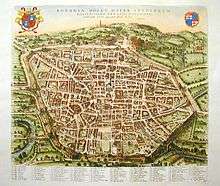
The period of Papal rule over Bologna has been generally evalued by historians as one of severe decline. However, this was not evident in the 1500s that were in fact marked by some major developments in Bologna. In 1530, Emperor Charles V was crowned in Bologna. In 1564, the Piazza del Nettuno and the Palazzo dei Banchi were built, along with the Archiginnasio, the main building of the university. The period of Papal rule saw also the construction of many churches and other religious establishments, and the restoration of older ones. At this time, Bologna had ninety-six convents, more than any other Italian city. Painters working in Bologna during this period established the Bolognese School which includes Annibale Carracci, Domenichino, Guercino and others of European fame.[24]
In the 17th century, the economy of Bologna started to show signs of severe decline as the global centres of trade shifted towards the Atlantic. During the Italian Plague of 1629–31 Bologna lost up to a third of its population.[25] The traditional silk industry was in a critical state.[26] The university was losing students, that once came from all over Europe, because of the illiberal attitudes of the Church towards culture (especially after the trial of Galileo).[27] Bologna continued to suffer a progressive deindustrialisation also in the 18th century.[28]
In the mid-1700s pope Benedict XIV, a Bolognese, tried to reverse the decline of the city with a series of reforms intended to stimulate the economy and promoting the arts. However, these reforms achieved only mixed results. The pope's efforts to stimulate the decaying textile industry had little success, while he was more successful in reforming the tax system and liberalising trade[29] and relaxed the oppressive system of censorship.[30]
The economic and demographic decline of Bologna became even more noticeable starting from the second half of the 18th century. In 1790 the city had 72,000 inhabitants, ranking as the second largest in the Papal States; however this figure had remained unchanged for decades. The economy was stagnant because of Papal policies that distorted trade with heavy custom dues and sold concessions of monopolies to single manufacturers thus lowering competition, depressing productivity and incentivising corruption.[31]
Late modern and contemporary
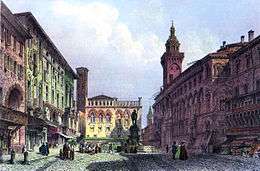
In 1796 Napoleon entered Bologna, making it the capital of the short lived Cispadane Republic, a client state of the French Empire. After the fall of Napoleon, the Congress of Vienna of 1815 placed Bologna once again under the oppressive rule of the Papal States, leading to the unsuccessful uprisings of 1831. By the mid 1840s, unemployment levels were very high and traditional industries continued to languish or disappear; Bologna became a city of economic disparity with the top 10 percent of the population living of rent, another 20 percent exercising professions or commerce and 70 percent working in low-paid, often insecure manual jobs. The Papal census of 1841 reported 10,000 permanent beggars and another 30,000 (out of a total population of 70,000) who lived in poverty.[32] In the revolutions of 1848 the Austrian garrisons which controlled the city on behalf of the Pope were temporarily expelled, but eventually came back and crashed the revolutionaries. Finally, in the aftermath of Second War of Italian Independence, when the French and Pidemontese troops expelled the Austrians from Italian lands, on 11 and 12 March 1860 Bologna voted for joining the new Kingdom of Italy.
In the last decades of the 19th century, Bologna once again thrived economically and socially. In 1863 Naples was linked to Rome by railway, and the following year Bologna to Florence.[33] Bolognese moderate agrarian elites, that supported liberal insurgencies against the papacy and were admirers of the British political system and of free trade, envisioned a unified national state that would open a bigger market for the massive agricultural production of the Emilian plains.[34] Indeed, Bologna gave Italy one of its first prime ministers, Marco Minghetti.
After World War I, Bologna was heavily involved in the Biennio Rosso socialist uprisings. As a consequence, the traditionally moderate elites of the city turned their back on the progressive faction and gave their support to the rising Fascist movement of Benito Mussolini.[35] Dino Grandi, a high-ranking Fascist party official and Ministry of Foreign Affairs, remembered for being an Anglophile, was from Bologna. During the interwar years, Bologna developed into an important manufacturing centre for food processing, agricultural machinery and metalworking. The Fascist regime poured in massive investments, for example with the setting up of a giant tobacco manufacturing plant in 1937.[36]
World War II
Bologna suffered extensive damage during World War II. The strategic importance of the city as an industrial and railway hub connecting northern and central Italy made it a strategic target for the Allied forces. On 24 July 1943, a massive aerial bombardment destroyed a significant part of the historic city centre and killed about 200 people. The main railway station and adjoining areas were severely hit, and 44% of the buildings in the centre were listed as having been destroyed or severely damaged. The city was heavily bombed again on 25 September. The raids, which this time were not confined to the city centre, left more than 1,000 people dead and thousands injured.[37]
After the armistice of 1943, the city became a key centre of the Italian resistance movement. On 7 November 1944, a pitched battle around Porta Lame, waged by partisans of the 7th Brigade of the Gruppi d'Azione Patriottica against Fascist and Nazi occupation forces, did not succeed in triggering a general uprising, despite being one of the largest resistance-led urban conflicts in the European theatre.[38] Resistance forces entered Bologna on the morning of 21 April 1945. By this time, the Germans had already largely left the city in the face of the Allied advance, spearheaded by Polish forces advancing from the east during the Battle of Bologna which had been fought since 9 April. First to arrive in the centre was the 87th Infantry Regiment of the Friuli Combat Group under general Arturo Scattini, who entered the centre from Porta Maggiore to the south. Since the soldiers were dressed in British outfits, they were initially thought to be part of the allied forces; when the local inhabitants heard the soldiers were speaking Italian, they poured out on to the streets to celebrate.
Post-war years
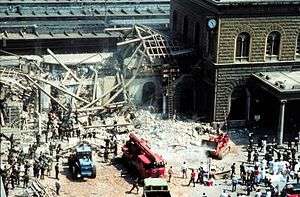
In the post-war years, Bologna became a thriving industrial centre as well as a political stronghold of the Italian Communist Party. Between 1945 and 1999, the city had an uninterrupted series of left-wing mayors, the first of whom was Giuseppe Dozza. At the end of the 1960s the city authorities, worried by massive gentrification and suburbanisation, asked Japanese archistar Kenzo Tange to sketch a master plan for a new town north of Bologna; however, the project that came out in 1970 was evaluated as way too much ambitious and expensive.[39] Eventually the city council, in spite of vetoing Tange's master plan, decided to keep his project for a new exhibition centre and business district.[40] At the end of 1978 the construction of a tower block and several diverse buildings and structures started.[41] In 1985 the headquarters of the regional government of Emilia-Romagna moved in the new district.[42]
In 1977 Bologna was the scene of rioting linked to the Movement of 1977, a spontaneous political movement of the time. The alleged police shooting of a far-left activist, Francesco Lorusso, sparked two days of street clashes. On 2 August 1980, at the height of the "years of lead", a terrorist bomb was set off in the central railway station of Bologna killing 85 people and wounding 200, an event which is known in Italy as the Bologna massacre. In 1995, members of the neo-fascist group Nuclei Armati Rivoluzionari were convicted for carrying out the attack, while Licio Gelli—Grand Master of the underground Freemason lodge Propaganda Due (P2)—was convicted for hampering the investigation, together with three agents of the secret military intelligence service SISMI (including Francesco Pazienza and Pietro Musumeci). Commemorations take place in Bologna on 2 August each year, culminating in a concert in the main square.
In 1999 the long tradition of left-wing mayors was interrupted by the victory of the independent candidate Giorgio Guazzaloca, who led a centre-right coalition; this brief experience ended in 2004 when Sergio Cofferati, a former trade union leader, was elected. The next centre-left mayor, Flavio Delbono, elected in June 2009, resigned in January 2010 after being involved in a corruption scandal. After a 15-month period in which the city was administered under Anna Maria Cancellieri (as a state-appointed prefect), Virginio Merola was elected as mayor, leading a left-wing coalition comprising the Democratic Party, Left Ecology Freedom and Italy of Values.[43]
Geography
Territory
.jpg)
Bologna is situated on the edge of the Po Plain at the foot of the Apennine Mountains, at the meeting of the Reno and Savena river valleys. As Bologna's two main watercourses flow directly to the sea, the town lies outside of the drainage basin of the River Po. The Province of Bologna stretches from the western edge of the Po Plain on the border with Ferrara to the Tuscan-Emilian Apennines. The centre of the town is 54 metres (177 ft) above sea level (while elevation within the municipality ranges from 29 metres (95 ft) in the suburb of Corticella to 300 metres (980 ft) in Sabbiuno and the Colle della Guardia). The Province of Bologna stretches from the Po Plain into the Apennines; the highest point in the province is the peak of Corno alle Scale (in Lizzano in Belvedere) at 1,945 metres (6,381 ft) above sea level.
Climate
Bologna has a humid subtropical climate (Köppen climate classification: Cfa).
Annual precipitation oscillates between around 450 mm (18 in) and 900 mm (35 in),[44] with the majority generally falling in spring and autumn. Snow occasionally falls during winter and heavy snowfalls; the last major event was in November 2012.[45]
| Climate data for Bologna (1971–2000, extremes 1946–present) | |||||||||||||
|---|---|---|---|---|---|---|---|---|---|---|---|---|---|
| Month | Jan | Feb | Mar | Apr | May | Jun | Jul | Aug | Sep | Oct | Nov | Dec | Year |
| Record high °C (°F) | 20.7 (69.3) |
24.9 (76.8) |
27.0 (80.6) |
30.6 (87.1) |
34.9 (94.8) |
37.3 (99.1) |
39.6 (103.3) |
39.7 (103.5) |
34.8 (94.6) |
29.8 (85.6) |
24.0 (75.2) |
23.0 (73.4) |
39.7 (103.5) |
| Average high °C (°F) | 6.0 (42.8) |
9.0 (48.2) |
14.2 (57.6) |
17.7 (63.9) |
23.0 (73.4) |
27.1 (80.8) |
30.4 (86.7) |
29.8 (85.6) |
25.4 (77.7) |
18.6 (65.5) |
11.1 (52) |
6.8 (44.2) |
18.3 (64.9) |
| Daily mean °C (°F) | 2.8 (37) |
5.0 (41) |
9.2 (48.6) |
12.5 (54.5) |
17.5 (63.5) |
21.4 (70.5) |
24.4 (75.9) |
24.1 (75.4) |
20.1 (68.2) |
14.4 (57.9) |
7.7 (45.9) |
3.6 (38.5) |
13.6 (56.5) |
| Average low °C (°F) | −0.5 (31.1) |
0.9 (33.6) |
4.1 (39.4) |
7.4 (45.3) |
12.0 (53.6) |
15.7 (60.3) |
18.5 (65.3) |
18.4 (65.1) |
14.8 (58.6) |
10.1 (50.2) |
4.3 (39.7) |
0.4 (32.7) |
8.8 (47.8) |
| Record low °C (°F) | −18.8 (−1.8) |
−14.4 (6.1) |
−9.7 (14.5) |
−4.5 (23.9) |
0.8 (33.4) |
7.0 (44.6) |
9.0 (48.2) |
9.7 (49.5) |
4.5 (40.1) |
−1.8 (28.8) |
−9.0 (15.8) |
−13.4 (7.9) |
−18.8 (−1.8) |
| Average precipitation mm (inches) | 34.0 (1.339) |
44.3 (1.744) |
54.2 (2.134) |
74.2 (2.921) |
58.0 (2.283) |
57.3 (2.256) |
40.5 (1.594) |
52.5 (2.067) |
67.5 (2.657) |
72.3 (2.846) |
68.0 (2.677) |
48.5 (1.909) |
671.3 (26.429) |
| Average precipitation days (≥ 1.0 mm) | 5.9 | 5.6 | 7.1 | 8.2 | 8.1 | 6.1 | 4.2 | 5.2 | 5.4 | 7.1 | 6.4 | 5.8 | 75.1 |
| Average relative humidity (%) | 83 | 78 | 70 | 71 | 69 | 68 | 65 | 66 | 69 | 76 | 84 | 84 | 74 |
| Mean monthly sunshine hours | 77.5 | 96.1 | 151.9 | 174.0 | 229.4 | 255.0 | 291.4 | 260.4 | 201.0 | 148.8 | 81.0 | 74.4 | 2,040.9 |
| Source: Servizio Meteorologico (sun and humidity 1961–1990)[46][47][48] | |||||||||||||
Government
| Bologna City Council Consiglio Comunale di Bologna | |
|---|---|
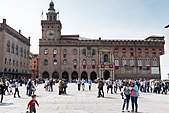 | |
| Leadership | |
Mayor | |
| Structure | |
| Seats | 32 |
 | |
Political groups | |
| Elections | |
| Party-list proportional representation | |
Last election | 5–19 June 2016 |
| Meeting place | |
| Palazzo d'Accursio, Bologna | |
| Website | |
| Official website | |
Municipal government
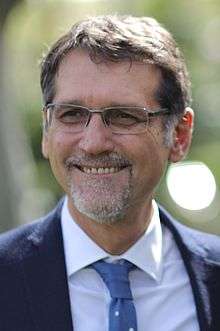
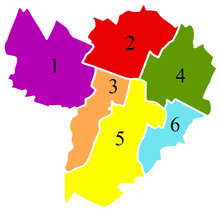
The legislative body of the municipality is the City Council (Consiglio Comunale), which is composed by 48 councillors elected every five years with a proportional system, contextually to the mayoral elections. The executive body is the City Committee (Giunta Comunale), composed by 12 assessors, that is nominated and presided over by a directly elected Mayor. The current mayor of Bologna is Virginio Merola (PD), elected on 16 May 2011 with the 50.5% of the votes.[49] On 19 June 2016 Merola was re-elected in a second-round ballot with 54.64% of votes.[50]
The municipality of Bologna is subdivided into six administrative Boroughs (Quartieri), down from the former nine before the 2015 administrative reform. Each Borough is governed by a Council (Consiglio) and a President, elected contextually to the city Mayor. The urban organization is governed by the Italian Constitution (art. 114). The Boroughs have the power to advise the Mayor with nonbinding opinions on a large spectrum of topics (environment, construction, public health, local markets) and exercise the functions delegated to them by the City Council; in addition they are supplied with an autonomous founding in order to finance local activities.
Provincial and regional government
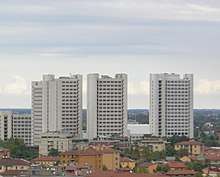
Bologna is the capital of the eponymous administrative province and of Emilia-Romagna, one of the twenty regions of Italy. While the Province of Bologna has a population of 1,007,644,[51] making it the twelfth most populated province of Italy, Emilia-Romagna ranks as the sixth most populated region of Italy, with about 4.5 million inhabitants, more than 7% of the national total. The seat of the regional government is Fiera District, a tower complex designed by Japanese architect Kenzo Tange in 1985.
According to the last governmental dispositions concerning administrative reorganisation, the urban area of Bologna is one of the 15 Metropolitan municipalities (città metropolitane), new administrative bodies fully operative since 1 January 2015.[52] The new Metro municipalities, giving large urban areas the administrative powers of a province, are conceived for improving the performance of local administrations and to slash local spending by better co-ordinating the municipalities in providing basic services (including transport, school and social programs) and environment protection.[53] In this policy framework, the Mayor of Bologna is designated to exercise the functions of Metropolitan mayor (Sindaco metropolitano), presiding over a Metropolitan Council formed by 18 mayors of municipalities within the Metro municipality.
The Metropolitan City of Bologna is headed by the Metropolitan Mayor (Sindaco metropolitano) and by the Metropolitan Council (Consiglio metropolitano). Since 21 June 2016 Virginio Merola, as mayor of the capital city, has been the mayor of the Metropolitan City.
Cityscape

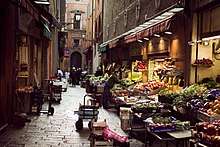
Until the late 19th century, when a large-scale urban renewal project was undertaken, Bologna was one of the few remaining large walled cities in Europe; to this day and despite having suffered considerable bombing damage in 1944, Bologna's 350 acres (141.64 ha) historic centre is Europe's second largest,[54] containing an immense wealth of important medieval, renaissance, and baroque artistic monuments.
Bologna developed along the Via Emilia as an Etruscan and later Roman colony; the Via Emilia still runs straight through the city under the changing names of Strada Maggiore, Rizzoli, Ugo Bassi, and San Felice. Due to its Roman heritage, the central streets of Bologna, today largely pedestrianized, follow the grid pattern of the Roman settlement. The original Roman ramparts were supplanted by a high medieval system of fortifications, remains of which are still visible, and finally by a third and final set of ramparts built in the 13th century, of which numerous sections survive. No more than twenty medieval defensive towers remain out of up to 180 that were built in the 12th and 13th centuries before the arrival of unified civic government. The most famous of the towers of Bologna are the central "Due Torri" (Asinelli and Garisenda), whose iconic leaning forms provide a popular symbol of the town.[55]
The cityscape is further enriched by its elegant and extensive porticoes, for which the city is famous. In total, there are some 38 kilometres (24 miles) of porticoes in the city's historical centre[56] (over 45 km (28 mi) in the city proper), which make it possible to walk for long distances sheltered from the elements.
The Portico di San Luca is possibly the world's longest.[57] It connects Porta Saragozza (one of the twelve gates of the ancient walls built in the Middle Ages, which circled a 7.5 km (4.7 mi) part of the city) with the Sanctuary of the Madonna di San Luca, a church begun in 1723 on the site of an 11th-century edifice which had already been enlarged in the 14th century, prominently located on a hill (289 metres (948 feet)) overlooking the town, which is one of Bologna's main landmarks. The windy 666 vault arcades, almost four kilometres (3,796 m or 12,454 ft) long, effectively links San Luca, as the church is commonly called, to the city centre. Its porticos provide shelter for the traditional procession which every year since 1433 has carried a Byzantine icon of the Madonna with Child attributed to Luke the Evangelist down to the Bologna Cathedral during the Feast of the Ascension.[56]
San Petronio Basilica, built between 1388 and 1479 (but still unfinished), is the tenth-largest church in the world by volume, 132 metres long and 66 metres wide, while the vault reaches 45 metres inside and 51 metres in the facade. With its volume of 258,000 m³, it is the largest (Gothic or otherwise) church built of bricks of the world.[58] The Basilica of Saint Stephen and its sanctuary are among the oldest structures in Bologna, having been built starting from the 8th century, according to the tradition on the site of an ancient temple dedicated to Egyptian goddess Isis. The Basilica of Saint Dominic is an example of Romanic architecture from the 13th century, enriched by the monumental tombs of great Bolognese glossators Rolandino de'Passeggeri and Egidio Foscherari. Basilicas of St Francis, Santa Maria dei Servi and San Giacomo Maggiore are other magnificent examples of 14th-century architecture, the latter also featuring Renaissance artworks such as the Bentivoglio Altarpiece by Lorenzo Costa. Finally, the Church of San Michele in Bosco is a 15th-century religious complex located on a hill not far from the city's historical cente.
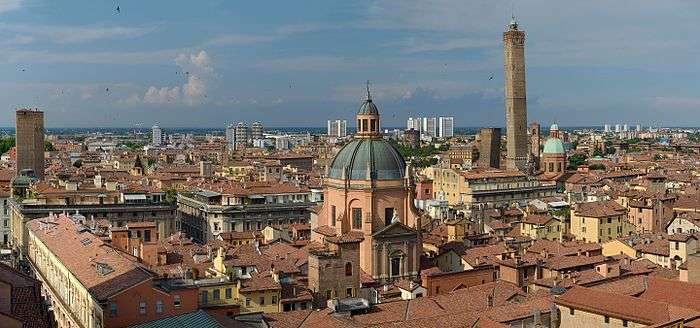
Economy
In terms of total GDP, the Metropolitan City of Bologna generated a value of about €35 billion ($40.6 billion) in 2017, equivalent to €34,251 ($40,165) per capita, the third highest figure among Italian provinces (after Milan and Bolzano/Bozen).[59]
The economy of Bologna is characterized by a flourishing industrial sector, traditionally centered on the transformation of agricultural and zootechnical products (Granarolo, Segafredo Zanetti, Conserve Italia), machinery (Coesia, IMA), energy (Hera Group), automotive (Ducati, Lamborghini), footwear, textile, engineering, chemical, printing and publishing (il Mulino, Zanichelli). The city has also a strong insurance (Unipol), consulting (Nomisma) and retail (Coop Italia, Conad) sectors.
In particular, Bologna is considered the centre of the so-called "packaging valley", an area well known for its high concentration of firms specialised in the manufacturing of automatic packaging machines.[60] Furthermore, Bologna is well known for its dense network of cooperatives, a feature that dates back to the social struggles of farmers and workers in the 1800s and that today produces up to a third of its GDP[61] and occupies 265 thousand people in the Emilia-Romagna region.[62]
The city's Fiera District exhibition centre is one of the largest in Europe, extending over 375,000 m2 of covered and outdoors areas.[63] It hosts yearly international expos focused on the automobile sector (Bologna Motor Show), ceramics for the building industry (International Exhibition of Ceramic Tiles and Bathroom Furnishings) and food industry. Bologna is also a key railway and motorway hub in Italy, connecting the northern powerhouses of Lombardy and Venetia with Rome and the south.
Transport
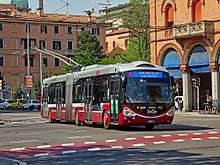
Bologna is home to the Guglielmo Marconi International Airport, recently[64] expanded to accommodate larger aircraft. Today, it is the seventh busiest Italian airport for passenger traffic (8 million passengers handled in 2017). Bologna Centrale railway station is one of the most important train hubs in Italy thanks to the city's strategic location. It serves 58 million passengers annually.[65] In addition, Bologna San Donato classification yard, with 33 railway tracks, is the largest in Italy by size and traffic.[66] The city is also served by a large network of public bus lines, including trolleybus lines, operated since 2012 by Trasporto Passeggeri Emilia-Romagna SpA (TPER).
A large commuter rail service is currently under development (see Bologna metropolitan railway service).
Bologna Public Transportation Statistics
The average amount of time people spend commuting with public transit in Bologna, for example to and from work, on a weekday is 53 min. 9% of public transit riders ride for more than 2 hours every day. The average amount of time people wait at a stop or station for public transit is 12 min, while 16% of riders wait for over 20 minutes on average every day. The average distance people usually ride in a single trip with public transit is 5.4 km, while 7% travel for over 12 km in a single direction.[67]
Demographics
At the end of 2016, the city proper had a population of 388,254 (while 1 million live in the greater Bologna area), located in the province of Bologna, Emilia Romagna, of whom 46.7% were male and 53.3% were female. Minors (children ages 18 and younger) totalled 12.86 percent of the population compared to pensioners who number 27.02 percent. This compares with the Italian average of 18.06 percent (minors) and 19.94 percent (pensioners). The average age of Bologna resident is 51 compared to the Italian average of 42. In the five years between 2002 and 2007, the population of Bologna grew by 0.0 percent, while Italy as a whole grew by 3.56 percent.[68] The current birth rate of Bologna is 8.07 births per 1,000 inhabitants compared to the Italian average of 9.45 births.
As of 2009, 89.47% of the population was Italian. The largest immigrant group came from other European countries (mostly Romanians and Albanians): 2.82%, East Asia (mostly Filipino): 1.50%, and South Asia (mostly from Bangladesh): 1.39%.[69]
Education
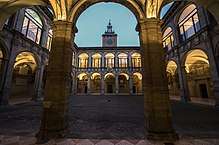
The University of Bologna, conventionally said to have been founded in 1088 by glossators Irnerius and Pepo,[70] is considered the oldest university in the world. It was an important centre of European intellectual life during the Middle Ages, attracting scholars from Italy and throughout Europe.[71] The Studium, as it was originally known, began as a loosely organized teaching system with each master collecting fees from students on an individual basis. The location of the early University was thus spread throughout the city, with various colleges being founded to support students of a specific nationality.
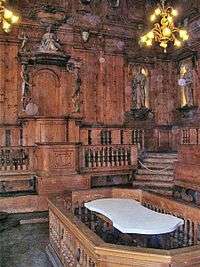
In the Napoleonic era, the headquarters of the university were moved to their present location on Via Zamboni, in the north-eastern sector of the city centre. Today, the University's 11 schools, 33 departments, and 93 libraries are spread across the city and include four subsidiary campuses in nearby Cesena, Forlì, Ravenna, and Rimini. Noteworthy students present at the university in centuries past included Dante, Petrarch, Thomas Becket, Pope Nicholas V, Erasmus of Rotterdam, Peter Martyr Vermigli, and Copernicus. Laura Bassi, appointed in 1732, became the first woman to officially teach at a college in Europe. In more recent history, Luigi Galvani, the discoverer of bioelectromagnetics, and Guglielmo Marconi, the pioneer of radio technology, also worked at the University. The University of Bologna remains one of the most respected and dynamic post-secondary educational institutions in Italy. To this day, Bologna is still very much a university town, with over 80,000 enrolled students in 2015. This community includes a great number of Erasmus, Socrates, and overseas students.[72] The university's botanical garden, the Orto Botanico dell'Università di Bologna, was established in 1568; it is the fourth oldest in Europe.
Bologna is also home to private tertiary institutions, such as the Bologna Center of Johns Hopkins University School of Advanced International Studies (SAIS). SAIS Bologna was founded in 1955 as the first campus of a US post-graduate school to open in Europe.[73] It was inspired by Marshall Plan efforts to build a cultural bridge between America and Europe.[74] Today, the Bologna Center also hosts the Associazione italo-americana "Luciano Finelli," which supports cross-cultural awareness and exchange between Italy and the United States.[75]
In addition, Bologna hosts a music school, Conservatorio Giovanni Battista Martini, established in 1804 and a art school, Accademia di Belle Arti di Bologna, founded in 1802. Both institutions were born as part of the reforms introduced by Napoleon Bonaparte.
Culture

Over the centuries, Bologna has acquired many nicknames: "the learned one" (la dotta) is a reference to its university; "the fat one" (la grassa) refers to its cuisine; "the red one" (la rossa), originally referring to the colour of the roofs in the historic centre, became later connected to the political leanings of the city, in particular after World War II: until the election of a centre-right mayor in 1999, the city was renowned as a bastion of the Italian Communist Party.[76] The centre-left regained power again in the 2004 mayoral elections, with the election of Sergio Cofferati. It was one of the first European cities to experiment with the concept of free public transport.[77]
The city of Bologna became a UNESCO City of Music on 26 May 2006. According to UNESCO, "As the first Italian city to be appointed to the Network, Bologna has demonstrated a rich musical tradition that is continuing to evolve as a vibrant factor of contemporary life and creation. It has also shown a strong commitment to promoting music as an important vehicle for inclusion in the fight against racism and in an effort to encourage economic and social development. Fostering a wide range of genres from classical to electronic, jazz, folk and opera, Bologna offers its citizens a musical vitality that deeply infiltrates the city's professional, academic, social and cultural facets."[78]
Entertainment and performing arts
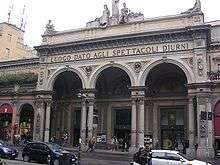
The theatre was a popular form of entertainment in Bologna until the 16th century. The first public theater was the Teatro alla Scala, active since 1547 in Palazzo del Podestà. An important figure of Italian Bolognese theatre was Alfredo Testoni, the playwright, author of The Cardinal Lambertini, which has had great theatrical success since 1905, repeated on screen by the Bolognese actor Gino Cervi. In 1998, the City of Bologna initiated the project "Bologna dei Teatri" (Bologna of the Theatres), an association of the major theatrical facilities in the city. This is a circuit of theatres which offer diverse theatrical opportunities, ranging from Bolognese dialect to contemporary dance, but with a communications strategy and promoting unity. Specifically, the shows on the bill in various theatres participating in the project are advertised weekly through a single poster. Bologna's opera house is the Teatro Comunale di Bologna. The Orchestra Mozart, whose music director was Claudio Abbado until his death in 2014, was created in 2004.
Bologna hosts a number of international music, art, dance and film festivals, including Angelica[79] Bologna and Contemporanea (festivals on contemporary music),[80] Bolognafestival (international classical music festival),[81] Bologna Jazz Festival,[82] Biografilm Festival (a film festival devote to biographic movies),[83] BilBolBul (a comics festival),[84] Danza Urbana (a street contemporary dance festival)[85] F.I.S.Co(festival on contemporary art, now merged in Live Arts Week) Future Film Festival (animation and special effects),[86]Il Cinema Ritrovato(film festival about rare and forgotten movies),[87] Live Arts Week, Gender Bender (festival on gender identity, sexual orientation and body representation),[88] Homework festival (electronic music festival),[89] Human Rights Film Festival,[90] Some Prefer Cake (lesbian film festival),[91] Zecchino d'Oro (a children's song contest).
Cuisine
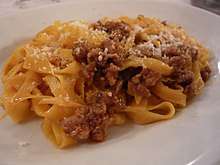
Bologna is renowned for its culinary tradition. It has baptised the famous Bolognese sauce, a meat-based pasta sauce that in Italy is called ragù and is substantially different from the variety found worldwide; moreover, in Bologna the sauce is used only as a dressing for tagliatelle, serving it with spaghetti being considered odd.[92] Situated in the fertile Po River Valley, the rich local cuisine depends heavily on meats and cheeses. As in all of Emilia-Romagna, the production of cured pork meats such as prosciutto, mortadella and salumi is an important part of the local food industry.[93] Well-regarded nearby vineyards include Pignoletto dei Colli Bolognesi, Lambrusco di Modena and Sangiovese di Romagna.[94] Tagliatelle with ragù, lasagne, tortellini served in broth, and mortadella, the original Bologna sausage, are among the local specialties.[95] Traditional Bolognese desserts are often linked to holidays, such as fave dei morti ("cookies of the dead"), multi-coloured almond paste cookies made for All Saints' Day, jam-filled raviole cookies that are served on Saint Joseph's Day, and carnival sweets known as sfrappole, a light and delicate fried pastry topped with powder sugar. Torta di riso, a custard-like cake made of almonds, rice and amaretto, is made throughout the year.[96]
Sport

A sporting nickname for Bologna is Basket City in reference to the successes of the town's two rival historic basketball clubs, Fortitudo and Virtus, though the clubs are now often referred to by the names of their current sponsors.[97] Of the two, the latter won 15 Italian basketball championships and two Euroleagues making them one of the most influential European basketball clubs; the former won two league titles between 1999 and 2005. The rivalry is temporarily dormant since Fortitudo left the country's professional ranks when, following the 2008–09 season, the club was relegated from the top-level Lega A to LegADue, before being relegated further to the nominally amateur Serie A Dilettanti for financial reasons; in the 2012–13 season, Fortitudo will play in the LegADue. The Italian Basketball League, which operates both Lega A and LegADue, has its headquarters in Bologna.
Football also has a strong tradition in Bologna. The city's main club, Bologna F.C. 1909, have won seven Italian league championships (the latest in 1963–64), which make them the sixth most successful team in the history of the league; in their heyday in the 1930s Bologna FC were called "Lo squadrone che tremare il mondo fa" (Italian for "The Team that Shakes the World"). The club play at the 38,000-capacity Stadio Renato Dall'Ara, which has hosted the Italian national team in both football and rugby union, as well as the San Marino national football team. It was also a venue at the 1990 FIFA World Cup.
Rugby union is also present in the city: Rugby Bologna 1928 is not only one of the oldest Italian rugby union clubs but also the first ever club affiliated to the Italian rugby union federation.[98] and, to date (2014) is Italy's oldest rugby union club still in operation. The club took part to the top tier of the Italian championship for the first 25 years of their history never winning the title but getting to the runner-up place several times; they returned in top division (Serie A1 then Super 10), in the late 1990s and faced serious financial problems which led them to the relegation and almost to disappearance.
People
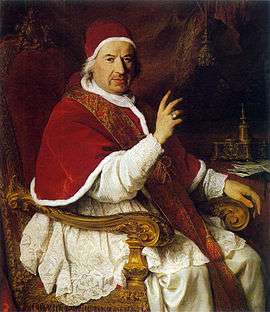
- Ulisse Aldrovandi (naturalist, 1522–1605)
- Antonio Alessandrini (anatomist and parasitologist, 1786–1861)
- Maria Gaetana Agnesi (mathematician, humanitarian, and linguist, 1718–1799)
- Amico Aspertini (painter, c. 1474–1552)
- Pupi Avati (director, born 1938)
- Riccardo Bacchelli (writer, 1891–1985)
- Adriano Banchieri (composer, 1568–1634)
- Agostino Barelli (architect, 1627–1687)
- Antonio Basoli (painter and scene designer, 1774–1848)
- Laura Bassi (scientist, first female appointed to university chair in Europe, 1711–1788)
- Ugo Bassi (Italian nationalist hero, executed for role in 1848 uprisings, 1800–1849)
- Pier Francesco Battistelli (painter of quadratura, 17th-century)
- Stefano Benni (writer, born 1947)
- Benedict XIV (Prospero Lambertini, Pope 1740–58)
- Giovanni II Bentivoglio (1443–1508)
- Giordano Berti (writer, born 1959)
- Amedeo Biavati (footballer, 1915–1979, credited with the invention of the stepover, World Champion 1938, played only for Bologna FC)
- Cristina D'Avena (actress and singer, born 1964)
- Francesco Ricci Bitti, Italian sports administrator
- Simone Bolelli (professional tennis player, born 1985)
- Giacomo Bolognini (painter, 1664–1734)
- Rafael Bombelli (mathematician, 1526–1572)
- Rossano Brazzi (actor, 1916–1994)
- Floriano Buroni (engraver, 17th-century)
- Raffaella Carrà (singer, born 1943)
- Annibale Carracci (painter, 1560–1609)
- Lodovico Carracci (painter, 1555–1619)
- Agostino Carracci (painter, 1557–1602)
- Chiara Caselli (actress, born 1967)
- Pier Ferdinando Casini (politician, born 1955)
- Pietro Cataldi (mathematician, 1548–1626)
- Pierluigi Collina (football referee, born 1960)
- Carlo Colombara (operatic bass, born 1964)
- Giovanni Paolo Colonna (composer, 1637–1695)
- Alessandro Cortini (musician, born 1976)
- Cesare Cremonini (songwriter, 1980)
- Giuseppe Maria Crespi (painter, 1665–1747)
- Donato Creti (painter, 1671–1749)
- Giulio Cesare Croce (cantastorie and writer, 1550–1609)
- Scipione del Ferro (mathematician, solved the cubic equation, 1465–1526)
- Francesco Francia (Francesco Raibolini, painter, c. 1450–1517)
- Lucio Dalla (singer-songwriter, 1943–2012)
- Domenichino (Domenico Zampieri, painter, 1581–1641)
- Elena Duglioli (Roman Catholic aristocrat, 1472–1520)
- Sara Errani (tennis player, born 1987)
- Gianfranco Fini (politician, born 1952)
- Aristotile Fioravanti (architect, c. 1415–c. 1486)
- Galeazzo Frudua (luthier and Beatles expert, birthdate unknown)
- Luigi Galvani (scientist, discoverer of bioelectricity, 1737–1798)
- Alessandro Gamberini, (footballer, born 1981)
- Serena Grandi (actress, born 1958)
- Gregory XIII (Ugo Boncompagni, Pope 1572–85, instituted the Gregorian Calendar)
- Gregory XV (Alessandro Ludovisi, Pope 1621–3)
- Il Guercino (Giovanni Barbieri, painter, 1591–1666)
- Irnerius (jurist, c. 1050–at least 1125)
- Blessed Imelda Lambertini (Dominican novice, Eucharistic mystic, and child saint, c. 1322–1333)
- Claudio Lolli (singer-songwriter, born 1950)
- Lucius II (Gherardo Caccianemici dell'Orso, Pope 1144–5)
- Marcello Malpighi (physiologist, anatomist and histologist, 1628–1694)
- Guglielmo Marconi (engineer, pioneer of wireless telegraphy, Nobel prize for Physics, 1874–1937)
- Giovanni Battista Martini (musical theorist, 1706–1784)
- Giuseppe Mezzofanti (cardinal, linguist and hyperpolyglot, 1774–1839)
- Marco Minghetti (economist and statesman, 1818–1886)
- Giorgio Morandi (painter, 1890–1964)
- Gianni Morandi (singer, born 1944)
- Ludovico Morbioli (Catholic layman, declared Blessed, 1433–1485)
- Edgardo Mortara (Catholic priest that was the subject of the Mortara Case during the Risorgimento, 1851–1940)
- Gianluca Pagliuca (footballer, born 1966)
- Pier Paolo Pasolini (writer, poet, director, 1922–1975)
- Roberto Regazzi (luthier, born 1956)
- Guido Reni (painter, 1575–1642)
- Ottorino Respighi (composer, 1879–1936)
- Augusto Righi (physicist, authority on electromagnetism, 1850–1920)
- Carlo Ruini (equine anatomist, 1530–1598)
- Angelo Schiavio (footballer, 1905–1990, scored the winning goal in extra time in the 1934 for Bologna)
- Elisabetta Sirani (painter, 1638–1665)
- Alberto Tomba (skier, born 1966)
- Ondina Valla (first Italian woman Olympic gold medalist, 1916–2006)
- Mariele Ventre (teacher and educator, founder of Piccolo Coro dell' Antoniano choir, 1939–1995)
- Christian Vieri (footballer, born 1973)
- Vitale da Bologna (painter, fl. 1330, d. 1361)
- Anteo Zamboni (anarchist who at the age of 15 attempted to assassinate Benito Mussolini, 1911–1926)
- Alex Zanardi (racing driver, born 1966)
- Marco Aurelio Zani de Ferranti (writer, musician, and composer, 1801–1878)
- Alessandro Carloni (director, animator, artist who worked on films like Kung Fu Panda and The Croods, born 1978)
In addition to the natives of the city listed above, the following have made Bologna their home:
- Giosuè Carducci (poet and academic, Nobel Prize for Literature, born near Lucca, Tuscany, 1835–1907)
- Carlo Felice Cillario (Italian conductor of international renown, founder of the Bologna Chamber Orchestra in 1946 (7 February 1915 – 13 December 2007)
- Umberto Eco (writer and academic, born in Alessandria, Piedmont, 1932–2016)
- Enzio of Sardinia (born c. 1218, King of Sardinia and illegitimate son of Emperor Frederick II, was imprisoned in Palazzo Re Enzo from 1249 until his death in 1272)
- Vasco Errani (politician, born 1955)
- William Girometti (painter, born in Milan, 1924-1998)
- Alfonso Lombardi (sculptor, born in Ferrara, c. 1497–1537)
- Niccolò dell'Arca (sculptor, born in Bari, c. 1435/1440–2 March 1494)
- Juan Ignacio Molina (naturalist, born in Chile, 1740–1829)
- Giovanni Pascoli (poet and academic, born in San Mauro di Romagna, 1855–1912)
- St. Petronius (San Petronio, bishop of Bologna and patron saint of the city, birthplace unknown, died c. 450 AD)
- Romano Prodi (economist, politician, born in Scandiano, Reggio Emilia, 1939)
- Gioachino Rossini (opera composer, born in Pesaro, 1792–1868)
- Giuseppe Torelli (composer, born in Verona, 1658–1709)
- Wu Ming (collective of writers, active since 2000)
- Farinelli (Carlo Broschi, castrato opera singer, 1705–1782)
Companies
- COESIA Group – G.D (packaging)[99]
- CIBO- Culinary Institute of Bologna – (Culinary-Cooking School))[100]
- Coop (supermarket chain)
- Ducati Motor Holding (motorcycles)
- IMA S.p.A (packaging)
- Lamborghini (cars)
- Malaguti (motorcycles)
- Macron
- Maserati (cars)
- OMAS (writing instruments)
- Segafredo Zanetti – (coffee)
- Unipol – (bank and insurance)
- YOOX Group Spa – (Fashion / Online Apparel Retailer)
International relations
Bologna is twinned with:
|
See also
References
- ↑ "ISTAT, Rapporto UrBes 2015 Bologna" (PDF). istat.it. Retrieved 11 May 2017.
- ↑ "La popolazione di Bologna al 29 febbraio 2016". Comune.bologna.it. Retrieved 30 November 2016.
- ↑ Romy Grieco, Bologna: a city to discover(1976) pp 8-12, 138-45.
- ↑ Top Universities Archived 17 January 2009 at the Wayback Machine. World University Rankings Retrieved 6 January 2010
- ↑ Our History – Università di Bologna
- ↑ Paul L. Gaston (2010). The Challenge of Bologna. p. 18. ISBN 1-57922-366-4. Retrieved 7 July 2016.
- 1 2 Hunt Janin: "The university in medieval life, 1179–1499", McFarland, 2008, ISBN 0-7864-3462-7, p. 55f.
- 1 2 de Ridder-Symoens, Hilde: A History of the University in Europe: Volume 1, Universities in the Middle Ages, Cambridge University Press, 1992, ISBN 0-521-36105-2, pp. 47–55
- ↑ "Bologna history – Bologna culture – Bologna – attractions in Bologna – art Bologna – history guide Bologna". Travelplan.it. Retrieved 19 April 2010.
- ↑ "The Italian UNESCO Creative Cities under the lead of Bologna - Bologna Città della Musica". cittadellamusica.comune.bologna.it. Retrieved 2018-10-03.
- ↑ "European growth cities". City Mayors. Retrieved 24 January 2014.
- ↑ "Qualità della vita". Il Sole 24 ORE. Retrieved 5 December 2011.
- ↑ Hornblower, Simon; et al. (2012). The Oxford classical dictionary (3rd ed.). Oxford: Oxford University Press. p. 230. ISBN 978-0199545568.
- ↑ Butler, Alban (1814). The Lives Of The Fathers, Martyrs, And Other Principal Saints. London: John Murphy.
- ↑ Heers, Jacques (1995). La città nel medioevo in Occidente : paesaggi, poteri e conflitti. Milano: Jaca Book. p. 63. ISBN 978-8816403741.
- ↑ Kleinhenz, Christopher (2004). Medieval Italy : an encyclopedia. New York: Routledge. p. 134. ISBN 978-0415939294.
- ↑ Luzzatto, Gino (2015). An Economic History of Italy: From the Fall of the Empire to the Beginning of the 16th Century (1st ed.). Abingdon-on-Thames: Routledge;. p. 111. ISBN 978-1138864955.
- ↑ Nove secoli di storia – Università di Bologna
- ↑ Nancy G. Siraisi, Taddeo Alderotti and his pupils: two generations of Italian medical learning (Princeton University Press, 1981).
- ↑ Janin, Hunt (2008). The university in medieval life, 1179-1499. Jefferson, NC: McFarland & Co. p. 56. ISBN 978-0786434626.
- ↑ Arnaldi, Girolamo (2008). Italy and its invaders. Cambridge, Mass.: Harvard University Press. p. 111. ISBN 978-0674030336.
- 1 2 Partner, Peter (1972). The lands of St. Peter : the papal state in the Middle Ages and the early Renaissance. Berkeley: Univ. of California Pr. pp. 318–327. ISBN 978-0520021815.
- ↑ Wray, Shona Kelly (2009). Communities and crisis : Bologna during the Black Death. Leiden: Brill. pp. 95–96. ISBN 9004176349.
- ↑ Raimond Van Marle. The Development of the Italian Schools of Painting, Volume 4 (1924) pp 394-481.
- ↑ Black, Christopher F. (2001). Early Modern Italy a Social History ([Online-Ausg.] ed.). New York: Routledge. p. 23. ISBN 978-0415214346.
- ↑ Pullan, edited with an introduction by Brian (2006). Crisis and change in the Venetian economy in the sixteenth and seventeenth centuries. London: Routledge. p. 132. ISBN 978-0415377003.
- ↑ Gross, Hanns (2002). Rome in the Age of Enlightenment : the Post-Tridentine Syndrome and the Ancien Regime. Cambridge: Cambridge University Press. p. 238. ISBN 978-0521893787.
- ↑ Gross, Hanns (2002). Rome in the Age of Enlightenment : the Post-Tridentine Syndrome and the Ancien Regime. Cambridge: Cambridge University Press. p. 89. ISBN 978-0521893787.
- ↑ Wright, A.D. (2000). The early modern papacy : from the Council of Trent to the French Revolution, 1564-1789. Harlow, England: Longman. p. 261. ISBN 978-0582087477.
- ↑ Messberger, Rebecca; et al. (2016). Benedict XIV and the Enlightenment: Art, Science, and Spirituality. Toronto: University of Toronto Press. p. 211. ISBN 978-1442637184.
- ↑ Hearder, Harry (1994). Italy in the age of the Risorgimento : 1790 - 1870 (7. impr. ed.). London: Longman. p. 121. ISBN 978-0582491465.
- ↑ Hughes, Steven C. (1993). Crime, disorder, and the Risorgimento : the politics of policing in Bologna (1. publ. ed.). Cambridge: Cambridge University Press. p. 17. ISBN 978-0521444507.
- ↑ Toniolo, Gianni. An Economic History of Liberal Italy: 1850-1918. Abingdon-on-Thames: Routledge. p. 46. ISBN 9781138830523.
- ↑ Cardoza, Anthony L. (2016). Agrarian Elites and Italian Fascism: The Province of Bologna, 1901-1926. Princeton, New Jersey: Princeton University Press. pp. 32–40. ISBN 9780691641409.
- ↑ Cardoza, Anthony L. (2016). Agrarian Elites and Italian Fascism: The Province of Bologna, 1901-1926. Princeton, New Jersey: Princeton University Press. pp. 387–88. ISBN 9780691641409.
- ↑ Sabel, Charles F.; et al. (1997). World of possibilities : flexibility and mass production in western industrialization (1. publ. ed.). Cambridge [u.a.]: Cambridge Univ. Press. pp. 382–88. ISBN 978-0521495554.
- ↑ Manaresi, Filippo D'Ajutolo. Testi di Franco (1999). Bologna ferita : fotografie inedite 1943 - 1945. Bologna: Ed. Pendragon. p. 18. ISBN 9788883420177.
- ↑ "7 novembre 1944 – Battaglia di Porta Lame". Il Museo Virtuale della Certosa (in Italian). Certosa.cineca.it. Archived from the original on 7 July 2012. Retrieved 2 May 2012.
- ↑ Heath, Tim; et al. (2001). Revitalizing historic urban quarters (Reprinted. ed.). Oxford: Architectural Press. p. 107. ISBN 978-0750628907.
- ↑ Ghirardo, Diane Yvonne (2013). Italy: Modern Architectures in History (1. publ. ed.). London: Reaktion. p. 283. ISBN 978-1861898647.
- ↑ ""Chronology of Bologna: 1927" (in Italian)". www.bibliotecasalaborsa.it. Salaborsa Library. Retrieved 30 November 2017.
- ↑ ""La Regione e la sua storia - le sedi della regione" (in Italian)". www.regione.emilia-romagna.it. Emilia-Romagna region. Retrieved 1 December 2017.
- ↑ See Virginio Merola. "Benvenuti a Bologna - Welcome to Bologna" Oct 18, 2016
- ↑ "Dati statistici temperature e precipitazioni dal 1991 al 2009". comune.bologna.it. Retrieved 24 January 2014.
- ↑ "Febbraio 2012, ma quanta neve è caduta?" (PDF). ARPA Emilia-Romagna. Retrieved 5 March 2014.
- ↑ "Bologna/Borgo Panigale (BO)" (PDF). Atlante climatico. Servizio Meteorologico. Retrieved 5 December 2014.
- ↑ "STAZIONE 140 BOLOGNA: medie mensili periodo 61 – 90". Servizio Meteorologico. Retrieved 5 December 2014.
- ↑ "Bologna Borgo Panigale: Record mensili dal 1946" (in Italian). Servizio Meteorologico dell’Aeronautica Militare. Retrieved 11 December 2014.
- ↑ tpel=G&dtel=15/05/2011&tpa=I&tpe=C&lev0=0&levsut0=0&lev1=8&levsut1=1&lev2=13&levsut2=2&lev3=60&levsut3=3&ne1=8&ne2=13&ne3=130060&es0=S&es1=S&es2=S&es3=N&ms=S Elezioni 2011, Ministero dell'Interno.
- ↑ Ballottaggio 2016, Merola confermato sindaco
- ↑ "Demographic Balance for the year 2017 (provisional data)". Istat. Retrieved 4 November 2017.
- ↑ "Spending Review Act". Italian Government. Archived from the original on 14 July 2012. Retrieved 18 October 2012.
- ↑ Vittorio Ferri (2009). "Metropolitan cities in Italy. An institution of federalism" (PDF). University of Milan-Bicocca. Retrieved 23 May 2011.
- ↑ National League of Cities, American Municipal Association (1976). Nation's cities, Volume 14. United States: National League of Cities.
- ↑ "The Two Towers: Garisenda e degli Asinelli". artcityemiliaromagna.com. Official tourism promotion website of Emilia-Romagna region. Retrieved 4 November 2017.
- 1 2 "The Porticoes of Bologna" (World Heritage Site submission). UNESCO World Heritage Centre. 1 June 2006. Retrieved 29 June 2012.
- ↑ Caird, Joe (16 January 2009). "Bologna city guide: top five sights". The Daily Telegraph. Retrieved 1 June 2013.
- ↑ data from http://www.bolognawelcome.com, Basilica di San Petronio plus calculations as follows:
- San Petronio de Bologna: The footplan of the building is a simple rectangle
- Area = length of the building x width of the building = 132 m x 60 m
- The volume, without the roofs, can be calculated as a sum of five cuboids, one single (the central nave) and two pairs (the aisles and the files of chapels). The sum each of the pairs can be calculated as one cuboid of double width. Knowing the height of the central nave and the width of the building, the measures of the sections can be calculated by measuring an orthograde photo of the facade.
- Volume = (traverse section of the central nave [width = 22 m, height = 44.27 m] + sum of the traverse sections of the two aisles [width = 20 m, height = 29.06 m] + sum of the traverse sections of the two files of chapels [width = 18 m, height = 22.38 m]) x length of the building [132 m]
- (973.94 + 581.2 + 402.84) x 132 = 1,957.98 x 132 = 258,453.36
- San Petronio de Bologna: The footplan of the building is a simple rectangle
- ↑ "Dossier on the Metropolitan City of Bologna" (PDF). Istat. Retrieved 4 November 2017.
- ↑ Fotis, Marco; et al. (2014). The Automatic Packaging Machinery Sector in Italy and Germany. Springer. pp. 1–2. ISBN 978-3-319-12762-0.
- ↑ Duda, John (5 July 2016). "The Italian Region Where Co-ops Produce a Third of Its GDP". YES! Magazine. Retrieved 4 November 2017.
- ↑ Caselli, Guido. "Osservatorio della cooperazione in Emilia-Romagna". Chamber of Commerce of Emilia-Romagna. Retrieved 4 November 2017.
- ↑ "The Exhibition Centre". bolognafiere.it. BiolognaFiere. Retrieved 4 November 2017.
- ↑ summer 2004
- ↑ "Bologna Centrale". Grandi Stazioni. Retrieved 30 December 2011.
- ↑ "The Bologna Freight Village" (PDF). Bologna Interporto S.p.a. Archived from the original (PDF) on 12 December 2013. Retrieved 1 June 2013.
- ↑ "Bologna Public Transportation Statistics". Global Public Transit Index by Moovit. Retrieved 19 June 2017.

- ↑ "istat". Demo.istat.it. Retrieved 19 April 2010.
- ↑ "istat". Demo.istat.it. Retrieved 19 April 2010.
- ↑ Rashdall, Hastings (2010). The universities of Europe in the Middle Ages. Cambridge: Cambridge university press. pp. 119–121. ISBN 978-1108018104.
- ↑ Ridder-Symoens, editor Hilde de (2003). A history of the university in Europe (1st pbk. ed.). Cambridge: Cambridge University Press. p. 12. ISBN 978-0521541138.
- ↑ "THE UNIVERSITY TODAY: NUMBERS AND INNOVATION". University of Bologna. Retrieved 4 November 2017.
- ↑ "American Centres — University of Bologna". Unibo.it. Retrieved 18 January 2016.
- ↑ "Remarks at the 50th Anniversary of SAIS in Bologna". 2001-2009.state.gov. 19 May 2005. Retrieved 18 January 2016.
- ↑ "Archived copy". Archived from the original on 21 January 2014. Retrieved 18 April 2014.
- ↑ "The red, the fat, and the learned: The story behind Bologna's curious nicknames". The Local. 10 May 2017. Retrieved 4 November 2017.
- ↑ "Repertoires of Democracy: The Case for Public Transport" (PDF). Archived from the original (PDF) on 25 March 2009. Retrieved 19 April 2010.
- ↑ "The Creative Cities Network: UNESCO Culture Sector". Portal.unesco.org. Archived from the original on 13 July 2012. Retrieved 19 April 2010.
- ↑ "Angelica". Aaa-angelica.com. Retrieved 19 April 2010.
- ↑ "Eventi Arte Contemporanea | Bologna contemporanea". Bolognacontemporanea.it. Retrieved 18 January 2016.
- ↑ "Bolonafestival". Bolognafestival.it. Retrieved 19 April 2010.
- ↑ "BolognaJazzFestival". BolognaJazzFestival.it. Retrieved 19 April 2010.
- ↑ "Biografilm Festival" (in Italian). Biografilm.it. Retrieved 19 April 2010.
- ↑ "BilBolBul". BilBolBul. Retrieved 19 April 2010.
- ↑ "Danza Urbana". Danzaurbana.it. Retrieved 19 April 2010.
- ↑ "futurefilmfestival". Futurefilmfestival.org. Retrieved 19 April 2010.
- ↑ "Il CInema Ritrovato". Cinetecadibologna.it. Retrieved 19 April 2010.
- ↑ "Gender Bender". Genderbender.it. Retrieved 19 April 2010.
- ↑ "homeworkfestival". homeworkfestival. Retrieved 19 April 2010.
- ↑ "Human Rights Film Festival". Cinetecadibologna.it. Retrieved 19 April 2010.
- ↑ "Archived copy". Archived from the original on 9 February 2012. Retrieved 19 August 2011.
- ↑ Cesarato, Monica (14 September 2016). "Why you won't find spaghetti bolognese in Italy". The Local. Retrieved 5 November 2017.
- ↑ Pauls, Dana Facaros & Michael (2000). Italy : Bologna & Emilia Romagna. London: Cadogan. p. 57. ISBN 978-1860119774.
- ↑ Anderson, Burton (2006). The Wines of Italy. An endless adventure in taste (8th ed.). The Italian Trade Commission. pp. 85–89. ASIN B002H6TK9C.
- ↑ Pauls, Dana Facaros & Michael (2000). Italy : Bologna & Emilia Romagna. London: Cadogan. p. 52. ISBN 978-1860119774.
- ↑ Pauls, Dana Facaros & Michael (2000). Italy : Bologna & Emilia Romagna. London: Cadogan. p. 60. ISBN 978-1860119774.
- ↑ Alexander Wolff (2003). "6". Big Game, Small World: A Basketball Adventure. Grand Central Publishing. ISBN 978-0-446-67989-3.
- ↑ Zanasi, Gianni (6 March 2009). "Rugby Bologna 1928 : quale futuro?" [What Future for Rugby Bologna 1928?]. air.it (in Italian). Associazione Italiana Rugbysti. Archived from the original on 5 November 2014. Retrieved 5 November 2014.
- ↑ "Coesia Group". Coesia.com. 26 October 2012. Archived from the original on 4 November 2012. Retrieved 26 March 2013.
- ↑ "CIBO – Culinary Institute of Bologna". Retrieved 9 May 2017.
- ↑ Griffin, Mary (2 August 2011). "Coventry's twin towns". Coventry Telegraph. Archived from the original on 6 August 2013. Retrieved 9 May 2017.
- ↑ "Coventry – Twin towns and cities". Coventry City Council. Archived from the original on 12 April 2013. Retrieved 6 August 2013.
- ↑ "Leipzig – Twin Cities". © 2015 Leipzig City Council, Office for European and International Affairs. Retrieved 23 December 2015.
- ↑ "Ciudades Hermanadas con València" [Valencia Twin/Sister Cities]. Ajuntament de València [City of Valencia] (in Spanish). Archived from the original on 29 October 2012. Retrieved 8 August 2013.
- ↑ "Intercity and International Cooperation of the City of Zagreb". © 2006–2009 City of Zagreb. Retrieved 23 June 2009.
Further reading
- Mancini, Giorgia, and Nicholas Penny, eds. The Sixteenth Century Italian Paintings: Volume III: Ferrara and Bologna (National Gallery Catalogues) (2016).
- Rashdall, Hastings. The Universities of Europe in the Middle Ages: Volume 1, Salerno, Bologna, Paris (2010).
- Robertson, Anne Walters. Tyranny under the Mantle of St Peter: Pope Paul II and Bologna (2002)
Guide books
- Grieco, Romy. Bologna: a city to discover(1976)
- Insight Guides. Pocket Bologna (2016).
- Noyes, Mary Tolaro. Bologna Reflections (2009).
Older guides
- "Bologna", Italy (2nd ed.), Coblenz: Karl Baedeker, 1870 ** "Bologna", Hand-book for Travellers in Northern Italy (16th ed.), London: John Murray, 1897, OCLC 2231483
- T. Francis Bumpus (1900), "Ferrara and Bologna", The Cathedrals and Churches of Northern Italy, London: Laurie
- "Bologna", Northern Italy (14th ed.), Leipzig: Karl Baedeker, 1913


